
Melaleuca huegelii, commonly known as chenille honey-myrtle, is a plant in the myrtle family, Myrtaceae and is endemic to the south-west coastal areas of Western Australia. It has small, almost scale-like leaves and flower spikes sometimes more than 100 millimetres (4 in) long on the ends many of its branches.
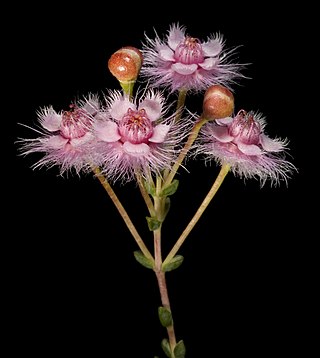
Verticordia insignis is a species of flowering plant in the myrtle family, Myrtaceae and is endemic to the south-west of Western Australia. It is an open, irregularly-branched shrub with small leaves and heads of relatively large pink, or white and pink flowers on the ends of the branches in spring.
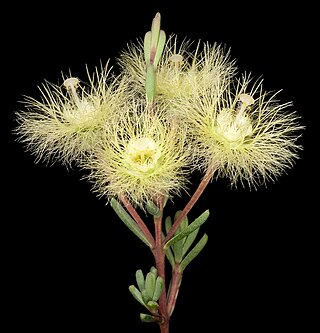
Verticordia huegelii, commonly known as variegated featherflower, is a flowering plant in the myrtle family, Myrtaceae and is endemic to the south-west of Western Australia. It is a sometimes an erect shrub, sometimes sprawling to almost prostrate. It has linear leaves and very feathery flowers in spring. The flowers are usually cream-coloured or white, becoming pinkish and reddish or maroon as the flowers age, giving a variegated appearance to the display.

Darwinia citriodora, commonly known as lemon-scented darwinia or lemon scented myrtle, is a plant in the myrtle family Myrtaceae and is endemic to the south-west of Western Australia. It is a shrub with oblong to lance-shaped leaves and red, yellow and orange flowers over an extended period. It is a hardy plant in well-drained soil, is often cultivated and used as a rootstock for less hardy species.

Verticordia pennigera, commonly known as native tea, is a flowering plant in the myrtle family, Myrtaceae, and is endemic to the south-west of Western Australia. It is usually a small erect or prostrate shrub with small leaves and lightly-scented spikes of pale pink to magenta-coloured flowers in spring.
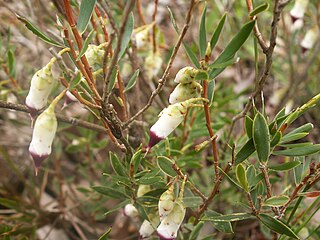
Conostephium is a genus of flowering plants in the family Ericaceae. The name of the genus comes from Greek words, conos, "cone" and stephanos, "that which encircles, a crown or wreath".
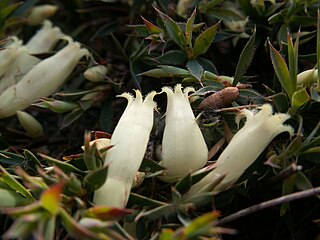
Astroloma pallidum, commonly known as kick bush, is usually a small, compact shrub in the family Ericaceae. The species is endemic to south-western Western Australia.
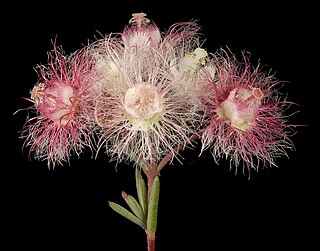
Verticordia huegelii var. huegelii, commonly known as variegated featherflower, is a flowering plant in the myrtle family, Myrtaceae and is endemic to the south-west of Western Australia. It is an upright, slender or bushy shrub, with creamish-white flowers turning pink or reddish maroon as they age, giving the plant a variegated appearance. It is similar to Verticordia huegelii var. decumbens but is more upright than that variety and lacks a lignotuber.
Verticordia huegelii var. tridens, commonly known as variegated featherflower, is a flowering plant in the myrtle family, Myrtaceae and is endemic to the south-west of Western Australia. It is a slender, open, sometimes straggly shrub with bright yellow flowers which age to red and then brown and differently-shaped staminodes from the other varieties of the species.

Darwinia vestita, commonly known as pom-pom darwinia, is a species of flowering plant in the family Myrtaceae and is endemic to the southwest of Western Australia. It is an erect, bushy shrub with crowded egg-shaped, oblong, or linear leaves and more or less spherical heads of white to reddish-pink flowers.

Boronia cymosa, commonly known as granite boronia, is a plant in the citrus family Rutaceae and is endemic to the south-west of Western Australia. It is an erect shrub with linear, more or less cylindrical leaves and groups of relatively small, pink four-petalled flowers arranged on branched flowering stems.

Conostephium minus, common name pink-tipped pearl flower, is a shrub in the Ericaceae family, endemic to Western Australia.

Goodenia fasciculata is a species of flowering plant in the family Goodeniaceae and is endemic to the south-west of Western Australia. It an ascending shrub with bunched, narrow linear stem leaves and spikes of white flowers.

Lechenaultia floribunda, commonly known as free-flowering leschenaultia, is a species of flowering plant in the family Goodeniaceae and is endemic to the south-west of Western Australia. It is an openly-branched shrub or subshrub with crowded, narrow, fleshy leaves and compact groups of pale blue to pale mauve or creamy white flowers.
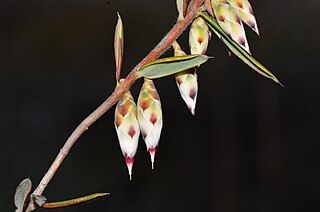
Conostephium hortiorum is a species of flowering plant in the family Ericaceae and is endemic to the south-west of Western Australia. It is a spreading shrub with linear, narrowly elliptic or narrowly triangular sharply-pointed leaves and pendulous, spindle-shaped, straw-coloured and dark purple flowers.
Conostephium drummondii is a species of flowering plant in the family Ericaceae and is endemic to the south-west of Western Australia. It is a slender, erect or spreading shrub that typically grows to a height of 0.3–1.5 m. It is a variable species with multi-coloured flowers from March to July or from November to December.

Leucopogon cochlearifolius is a species of flowering plant in the heath family Ericaceae and is endemic to the south-west of Western Australia. It is a bushy shrublet with many branchlets, triangular to spoon-shaped leaves, and white flowers arranged in clusters on short side-shoots.
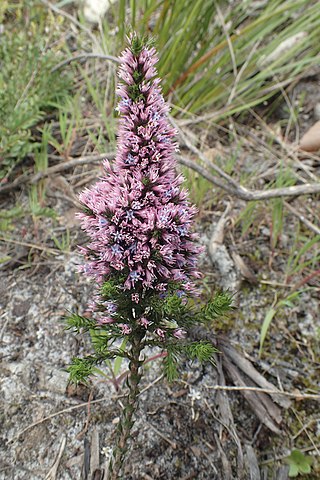
Andersonia caerulea, commonly known as foxtails, is a species of flowering plant in the family Ericaceae and is endemic to the southwest of Western Australia. It is an erect or spreading to low-lying shrub with variably-shaped leaves and pink and pale blue flowers, sometimes in spike-like groups.

Leucopogon glaucifolius is a species of flowering plant in the family Ericaceae and is endemic to the south-west of Western Australia. It is an erect or spreading shrub with linear, sharply-pointed leaves, and white, tube-shaped flowers.
Conostephium laeve is a species of flowering plant in the family Ericaceae and is endemic to the west of Western Australia. It is a compact shrub with erect, narrowly elliptic or narrowly egg-shaped leaves with the narrower end toward the base, and pendulous, spindle-shaped, cream to straw-coloured and pink flowers.


















